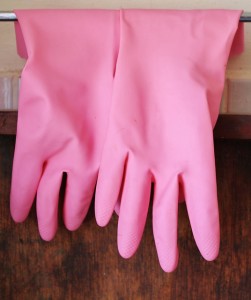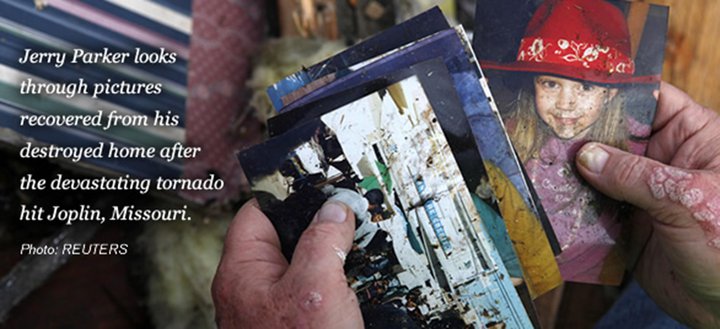There’s been a disaster in your area. A tornado has blown apart homes and businesses or a flood has swept away people’s precious belongings or water-logged them in corners of their homes. Any of several other types of disasters can result in similar damage and loss.
Can their lost photos be saved? They may be still on their property or they could be miles away scattered by wind or water. What if you find a photo dropped out of the sky or washed up in flood water? Is there any hope of, first, saving the photo, and second, returning it to its owner?
YES! If you come across these items, or if you have your own damaged photos or documents in your home, do not throw them away! They can usually be saved, dried, cleaned and even professionally restored, if needed.
But you need to take action quickly. Here is what we at National Disaster Photo Rescue, along with heritage preservation organizations, recommend for salvaging wet, damaged photos.
 Step 1: Keep safety in mind! If you are searching through debris for photos, be sure to wear rubber gloves (like they use in a hospital), possibly under leather work gloves if there is debris, and wear a FEMA-approved mask to prevent breathing in toxic substances such as mold.
Step 1: Keep safety in mind! If you are searching through debris for photos, be sure to wear rubber gloves (like they use in a hospital), possibly under leather work gloves if there is debris, and wear a FEMA-approved mask to prevent breathing in toxic substances such as mold.
Step 2: Have a plan. Its simple to deal with 1 or even a dozen wet photos. But what if you wind up finding hundreds of them? Where will you dry them? What will you do with them?
Step 3: When you are picking up photos, just put them into a trash bag or grocery bag until you can clean them. Don’t leave them in there for long though!
Step 4: If photos are wet AND very muddy, rinse them off in a bucket or sink of clear, plain water, but not under running water. You will need to change the water when it gets too dirty. Do NOT scrub them. Just shake them gently in the water to get the excess mud off. (We will show you what to do with the dry mud in a later step.)
Step 5: Wet photos need to be dried immediately, or frozen until later. If you need to freeze them, stack them loosely, possibly with wax paper in between, and put them in a zip lock bag. Store in the freezer until you can turn them over to someone, like a National Disaster Photo Rescue representative, or until you have time and space to air dry them.
Step 6: The best way to air dry photos is to lay them out flat, photo-side up, not touching any other photos. Be sure you do this on a clean hard surface that won’t be damaged or create more damage to the photos. Spread them out on wax paper, plain paper towels or plain (unprinted) newsprint paper. Do not spread them on printed newsprint or printed paper towels, because the ink can transfer. Leave them to dry for a few days. A fan and/or dehumidifier running in the room to circulate air, but not blowing directly on the photos, will help speed the process. Make sure photos are not in direct sunlight as they dry.
Step 7: Once photos are completely dry, they can be cleaned of any remaining mud or gunk by gently brushing them with used dryer sheets. As you do laundry, save your dryer sheets and when you have a few ready, use them until they look dirty. Laying the photos on a clean, dry dust-catching towel as you clean them will cut down on the dust. Be sure to wear some of those doctor-style plastic gloves and wear a dust mask while you clean the photos. (If there is a National Disaster Photo Rescue operation in your area, we suggest turning them over to our trained volunteers to handle the dirty work.)
Step 8: Clean, dry photos are ready to be put into new photo frames or returned to find their rightful owners. If National Disaster Photo Rescue is running a rescue project in the area, please turn them over to the local representative for return. Otherwise, you can scan them or take a picture of them and post it to Facebook to find the owner.
Step 9: Prevent the devestating loss of your memories in a future disaster. Scan and safely archive your photos today! Find someone with a high-speed scanner that can turn an otherwise month-long task into a task that takes a couple of hours. Or watch for a Save Your Photos Day in your area!
Do you want to volunteer with NDPR and help salvage and return photos lost in a disaster? You’ll find the volunteer application here.
For more information on salvaging other precious documents from rain or flood water, we have found these resources for you:
- Salvage At a Glance By Betty Walsh, British Columbia Information Management Services – Provides information on salvage of paper, fine art, books, older electronic devices, and different kinds of photograph materials.
- Save Your Treasure the Right Way provided by FEMA and Heritage Preservation.
- How to Salvage Wet/Sooty/Muddy/Dirty Papers, Books or Records by MJ Davis, Paper Conservator in Private Practice and Lead Trainer, American Institute for Conservation Collections Emergency Response Team, provided by Studio Protector, the Artist’s Guide to Emergencies.
- First Aid for Your A’s – Art, Assets, Archives provided by Studio Protector, the Artist’s Guide to Emergencies.
- Beating the Mold Monster: Salvaging Your A’s provided by Studio Protector, the Artist’s Guide to Emergencies.
